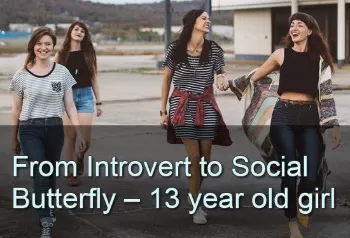Primitive Reflex Integration Case Studies
From Introvert to Social Butterfly-13 Yr Old Girl
From "guarded and introverted" to "a confident, expressive child delighting in her new-found skills and abilities."
Rhythmic movements make a huge difference for fine motor skills and extreme introversion in this 13-year-old girl managing epilepsy, anxiety, and ADHD.
Submitted by Nadia Roosendaal

| Before | After |
|---|---|
| Fine motor movements were uncoordinated and unrefined | Fine-motor skills for writing and drawing improved dramatically; content of free drawing increased in number and detail |
| Introverted | Chatty |
This is a young female aged 13 who attends a school that accommodates autistic, remedial, and gifted children. In early childhood, her Epilepsy was misdiagnosed so she only started taking anti-epileptic medication from around the age of 5, but by then her speech other areas had been negatively affected by the mini seizures she had experienced. She is currently on anti-epileptic, anti-anxiety, and ADHD medication. Her speech is unclear and her gross and fine motor movements are uncoordinated and unrefined.
After receiving the appropriate permission from her parents and medical clearance regarding her epilepsy, I started a series of 22 rhythmic movement [from the Brain and Sensory Foundations First Level course] sessions with her. She did P.A.C.E exercises daily as part of her school curriculum. From observation while she was busy with P.A.C.E. I noticed that she wanted to rush through the cross crawl and her rhythm was completely off when she did cross-crawl. The first three Rhythmic Movement (RM) sessions only lasted about three minutes each as I was cautious to ensure the movements would not trigger an epileptic fit. She loved the RM from the start and was happy and content after each session. By the eleventh session she was following the instructions clearly and could do the rhythmic movement actively with a very smooth and symmetrical movement pattern. She was very eager and happy while she did these movements and I encouraged her to hum instead of singing along with me as I found that she was so busy concentrating on the words of the song and the tune that she started tensing up which made smooth movements difficult.
By the sixteenth session she was coming out of her shell and chatting the hind leg off a donkey. With this new development, she also suddenly became quite stubborn and was not her usual compliant self. Her parents noticed that she was sleeping much better at night and also commented on her new-found stubborn streak. [Instructor comment: This sounds like the normal developmental stage of defiance coming out, which is a very good thing! She probably missed this stage as a younger child.]
By the twenty-second session her teacher had noticed that her fine-motor skills for writing and drawing had improved dramatically and the content of her free drawing had also increased in number and detail. Her movements were far smoother than at the start of the sessions and she had progressed from social caterpillar to social butterfly and was soon charming all around her with her wicked sense of humor. I have been motivated by watching her these past twenty-two sessions emerge from her guarded and introverted self into a confident, expressive child delighting in her new-found skills and abilities. I am humbled and grateful to have been part of her initial journey and I can’t wait to continue this work in the New Year.
[Edited for length and clarity; emphasis added]
*Disclaimer: The activities in the Brain and Sensory Foundations curriculum make use of the natural processes of neuroplasticity and development that are innately wired in the design of human beings to promote maturity and function. These activities appear to calm, organize, and mature the neuro-sensory-motor systems just as we see in the healthy development of human infants. Individual results may vary, and we do not claim to offer a diagnosis or cure for any specific condition or disorder. The Brain and Sensory Foundations activities appear to improve overall functioning resulting in measurable improvements for a range of conditions as demonstrated in over 1800 case studies from participants.

